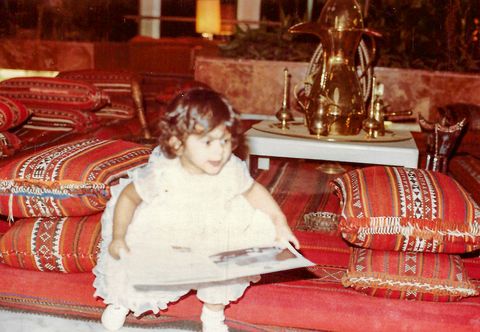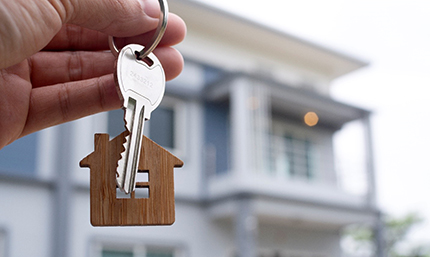Rydhima Brar is a Los Angeles-based interior designer and founder of R/terior Studio. Here, she describes how a childhood influenced by different cultures impacts her design today—and how she incorporates this influence into her young daughter’s life.
By most people’s standards, my childhood was highly unorthodox. Born in Kuwait to Indian parents, I spent my early years immersed in the Arab and Indian cultures of the East, combined with certain comforts and luxuries of the West. My sharpest memories are of lush fabrics, rich colors and scents, heirloom furniture, a vibrant family life, and the deep heritage preserved in centuries-old architecture.
Then, the Gulf War started.
My entire world shifted as we fled to India overnight. We stayed there for 3 whole years, waiting. When we finally returned to Kuwait, which we had always called home, I learned firsthand how to rebuild a life. The next time my story took a dramatic turn, it was, fortunately, by choice. In 2000, I moved to the U.S. to complete my undergraduate degree in Buffalo, New York. A job opportunity post-graduation took me from east coast to west, where I met my husband. When we had our daughter, we immediately started thinking about how to raise her. With love, freedom, and her heritage.
Making an early impression
I was one of those first time moms who read all the books. I learned that the years from a child’s birth to age 5 are foundational. Psychology and self-identity take shape at this time, and there is so much research around colors, shapes, educational materials, and when and how to introduce them to a baby and toddler to develop their senses and motor skills.
I followed those suggestions to a T, but I also thought, “How can I make sure that her culture is involved in this development? And not in a forced way, but in a natural way that feels like she’s living it?”
My answer: Interior design.
When I see a pattern of Indian origin, I’m immediately whisked back to my childhood home or holidays with my family. When I recently stumbled across a book about design in Kuwait, sunshine flooded my heart and I could see my father, a general contractor, hard at work in sprawling marble buildings lined with age-old tapestries.
Visualizing and storytelling
That’s how I want my daughter to feel when she encounters elements of her culture. I want her to feel connected to it and have personal stories she can tell and feel. For me, the first step is incorporating our heritage into our daily lives in natural and meaningful ways at home, whether it’s displaying a souvenir in an artistic display case, integrating wallpaper, rugs and tile, or showcasing special collectables from our family history. Even color can be used to pique her senses in the same way mine were as a child. As she makes memories in this space, those cultural elements shape the setting she will remember.
The second layer of helping her experience her culture in an authentic way is through storytelling. For most adults, incorporating cultural elements into their homes is enough to keep it alive and thriving; children, however, need context. Share the stories behind those special pieces, along with your own childhood experiences. Yes, reading books and learning about heritage is always a great way to educate children, but to be able to associate a story with yourself and your own childhood makes it more than a story — it becomes real.
We have a small temple in our home — it starts there. is is where I have shown her and taught her elements of my religious heritage. The Hindu gods take form in statues, and even though she is fairly young to really understand, it all starts with a visual experience.
Interior design is very much a tactile experience. It isn’t just about walls and furniture; it also includes the items in the home. I started to include various things from our culture, like a small baby tabla (musical instrument) with a baby drum set for her to play with.
During Diwali each year, I decorate and style our home with bright colorful accents, replacing my throw pillows with Indian motifs and blankets, surrounding our home with unique artwork from Kuwait and Hyderabad. I walk around the house and show her those images and tell her stories about them.
The effects
When our daughter was a baby, I was never sure if any of this was making a difference, but both my husband and I continued to use design and storytelling in our own way (he is Punjabi and practices a different Indian religion). I still don’t know which childhood memories will stand out the most to her, or how she’ll view her heritage, but here’s what I do know: Three years later, she now recognizes the images of the idols and associates them with religion, or she connects those images and patterns to me or my husband.
But between you and me, whether our efforts were working or not, I would still do it. This is is who I am. As first and second generation citizens, my daughter and I are both a blend of places, culture, colors, and stories.
Our stories will never be the same, and that’s okay. No two stories are the same. That’s what makes life so beautiful, don’t you think?
Follow House Beautiful on Instagram.
This content is created and maintained by a third party, and imported onto this page to help users provide their email addresses. You may be able to find more information about this and similar content at piano.io







More Stories
How to Score Big Buying a House on Auction
What is Design Psychology and How Will it Help Me?
Energy Efficient House Design – Using Thermal Performance Assessment Techniques